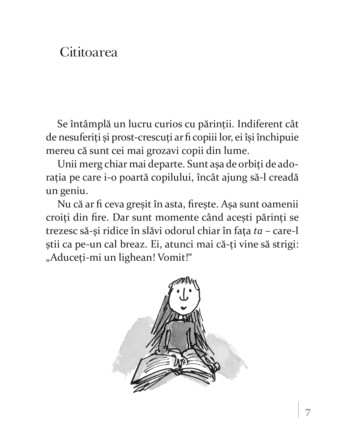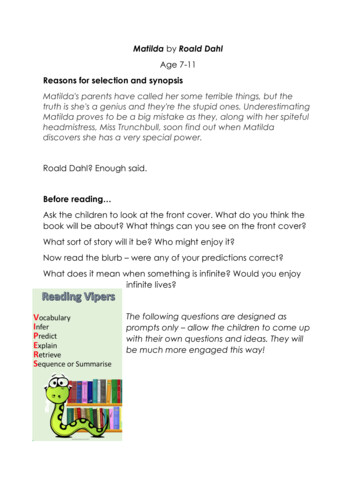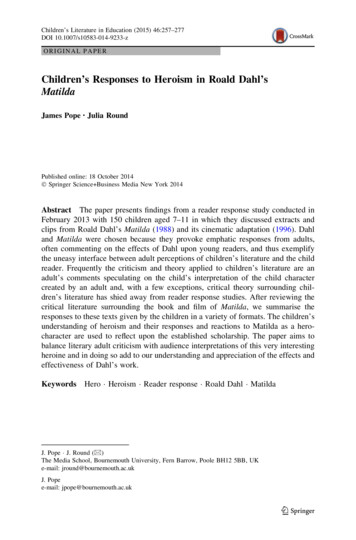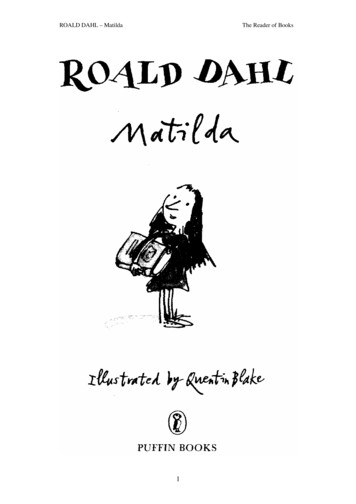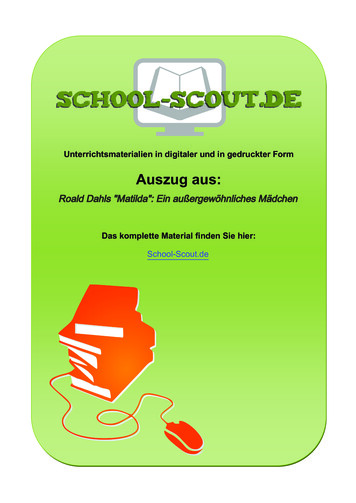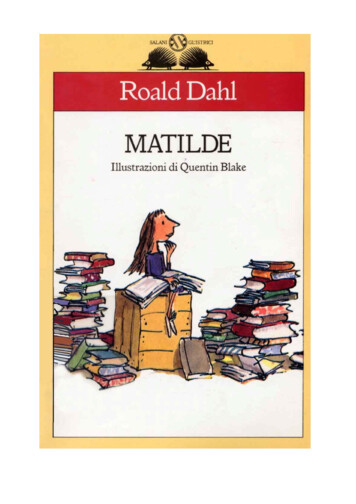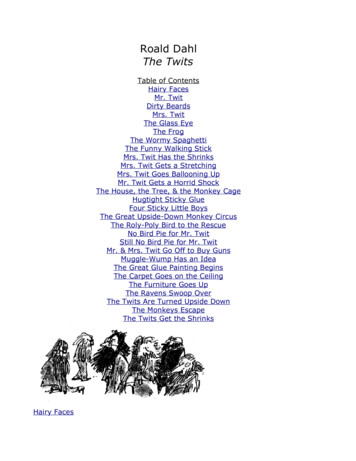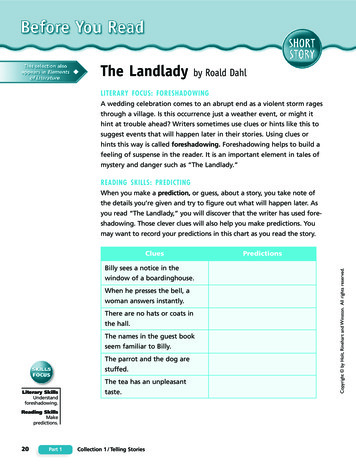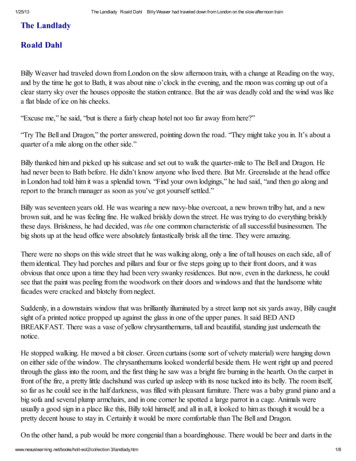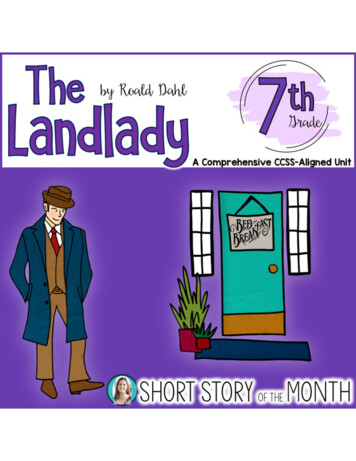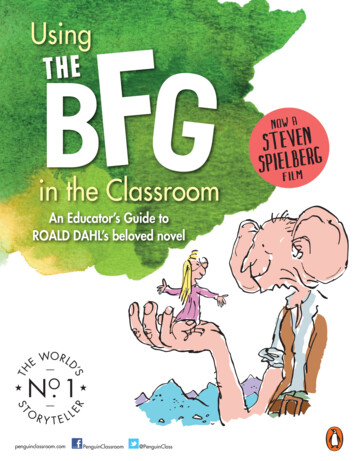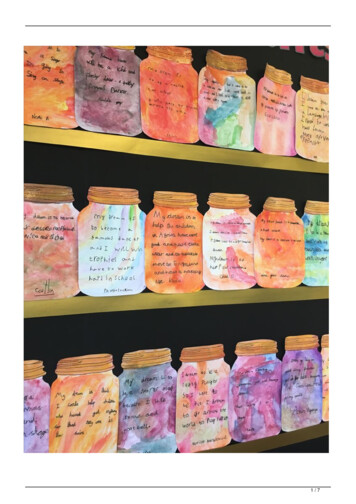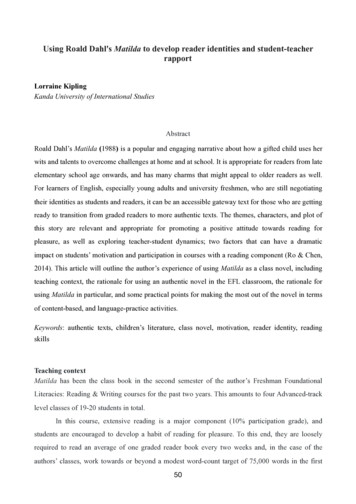
Transcription
Using Roald Dahl's Matilda to develop reader identities and student-teacherrapportLorraine KiplingKanda University of International StudiesAbstractRoald Dahl’s Matilda (1988) is a popular and engaging narrative about how a gifted child uses herwits and talents to overcome challenges at home and at school. It is appropriate for readers from lateelementary school age onwards, and has many charms that might appeal to older readers as well.For learners of English, especially young adults and university freshmen, who are still negotiatingtheir identities as students and readers, it can be an accessible gateway text for those who are gettingready to transition from graded readers to more authentic texts. The themes, characters, and plot ofthis story are relevant and appropriate for promoting a positive attitude towards reading forpleasure, as well as exploring teacher-student dynamics; two factors that can have a dramaticimpact on students’ motivation and participation in courses with a reading component (Ro & Chen,2014). This article will outline the author’s experience of using Matilda as a class novel, includingteaching context, the rationale for using an authentic novel in the EFL classroom, the rationale forusing Matilda in particular, and some practical points for making the most out of the novel in termsof content-based, and language-practice activities.Keywords: authentic texts, children’s literature, class novel, motivation, reader identity, readingskillsTeaching contextMatilda has been the class book in the second semester of the author’s Freshman FoundationalLiteracies: Reading & Writing courses for the past two years. This amounts to four Advanced-tracklevel classes of 19-20 students in total.In this course, extensive reading is a major component (10% participation grade), andstudents are encouraged to develop a habit of reading for pleasure. To this end, they are looselyrequired to read an average of one graded reader book every two weeks and, in the case of theauthors’ classes, work towards or beyond a modest word-count target of 75,000 words in the first50
semester, and 100,000 words in the second semester. To develop reading fluency, students areadvised to read graded reader books at, or preferably below, their reading comfort level, followingthe headword, or “basic word” principle (Nation, 2009, p. 52). These can be self-selected from theteacher’s class library, or from the university’s library or Self-Access Learning Centre (SALC).As the extensive reading grade is based on participation rather than attainment, students areassessed holistically according to how frequently they are working towards their target, as opposedto the exact number of books or words they read. As such, the number of books a student reads mayvary depending on their reading proficiency, book choice, and effort. Participation was monitoredinitially by using paper Reading Records, in which students recorded the book titles, reading dates,level of difficulty, etc, in tabular form. In 2017, the electronic platform MReader (mreader.org) wasadopted, with similar data being logged digitally when students pass short reading comprehensionquizzes.Through this monitoring of Reading Records, classroom observations, and conversationswith individuals, it was evident that some students were becoming avid readers, keen to move on tothe “next step” (i.e., authentic texts). However, some individuals started to lose motivation to readas the semester progressed, either not fully participating, or only doing the minimum requirement tomeet the extensive reading target. Aside from the usual time-constraints and workload issues whichare faced by many students towards the end of the semester (Ro & Chen, 2014, p. 59), hinderingtheir ability and motivation to practice reading outside class, one of the main challenges studentsreported was comprehension of detailed narratives.Despite having access to graded reader texts that were adjusted to a variety of levels,students talked about struggling to follow complex plots, and stories with multiple and secondarycharacters. In addition, they also complained that unknown vocabulary was frustrating their readingfluency. A low tolerance for ambiguity may be anticipated when unknown words are encountered inany context, and some dictionary use may be inevitable, since “learning [in extensive readingprogrammes] may at times be incidental and at times deliberate” (Webb & Chang, 2015). However,some students were still resorting to consistently using dictionaries while reading, and this wasimpeding their reading fluency. Although students were reminded of the extensive reading principleof selecting easy books, it seemed that they maintained ambitions to read books at a higher levelthan their fluency competency.In the second semester of 2016, Matilda was introduced as a class novel, to be read inaddition to the regular extensive reading requirement. It was hoped that this would not only providethe “level-up” to an authentic text, as desired by keen readers, but also allow for more scaffolded51
input for those students who were still learning how to appreciate longer and more detailednarrative texts. It was also hoped that the choice of book would provide plentiful stimulus for inclass discussion, and reflection on, the themes of reader identities and teacher-student models.Using an authentic narrative text (Matilda) in the EFL classroomHall (2005) summarizes the broad benefits of using authentic literature in the languageclassroom into three categories: affective, cultural, and psycholinguistic (i.e., linguistic processing,p. 48). These three factors seem to be symbiotic, since learners’ access to the cultural and linguisticbenefits of reading may only be truly accessed when the affective filter is lowered. When reading ismeaningful and interesting, students develop intrinsic motivation and enjoyment in the activity ofreading, and this can have a profound effect on language and literacy development (Lao & Krashen,2000, p. 262). Meanwhile, raising learners’ awareness of the cultural and linguistic advantages ofreading can help them to appreciate and enjoy the reading process, and feel encouraged andmotivated to participate in reading activities.In order to make the most of the advantages of using authentic literary texts, it is importantto select a text that is accessible in terms of learners’ skill levels, schematic understanding, andinterest. It should also have sufficiently challenging material to develop learners’ growth, and tostimulate creative, critical, and reflective responses. Matilda satisfies these requirements effectively,offering a rich resource of cultural, social, and personal themes for learners to discuss, as well asplentiful examples of interesting and creative language use, and implicit encouragement for learnersto be ambitious and resilient learners and readers.Cultural benefitsAuthentic narratives provide exposure to new cultural and social contexts through textssituated within the culture itself, as opposed to ones created specifically for language learnerslooking in from outside, thus helping to develop students’ personal L2 identities. Part of the appealof Matilda is no doubt due to the entertaining and accessible presentation of relatable cultural,social, and personal themes. A child’s journey through the first year of school, including encounterswith other children, teachers, new rules, expectations, and activities, should be familiar andsympathetic to anyone who has experienced formal education. Meanwhile, Dahl’s narrative isfirmly situated within the generic cultural context of a small English village, in a time beforeinternet and smartphones, thereby providing cultural insights and points of comparison to explore inthe EFL classroom. The content of the novel therefore provides stimulating themes that can be52
explored in discussions about family life, school experiences, and personal relationships, as well asin creative and critical responses (including writing projects, role plays, and debates), and individualpersonal reflections.Authentic texts also build learners’ cultural capital by accessing genuine and verifiablecultural artefacts available in the target culture. As Cook (2000) explains, “literary texts have theadvantage of being attested instances of communication [which] do not lose authenticity in theclassroom.” (p. 195) In the thirty years since its publication, Matilda has proved hugely popularwith a wide audience. In 1996 it was adapted into an award-winning movie (Devito, et al). Amusical adaptation (Kelly & Minchin), also award-winning, has toured internationally since itpremiered in 2010, and is due to be released as a motion picture sometime after 2019 (Gilbert,2013). In 2016 Matilda was voted second (below Harry Potter) in a list of the UK’s favouritechildren’s book heroes, with the antagonist Miss Trunchbull being voted the fifth most “evil villain”(World Book Day). Offering Matilda as a text to explore in class offers learners an opportunity toenhance their cultural capital by reading a famous and celebrated narrative, one which they mayalready have heard of and be interested in.Psycholinguistic benefitsThe psycholinguistic benefits of using authentic narrative texts are as varied as the languagefeatures available in literary works. Widdowson (1975) argues that exposure to the lexicogrammatical forms, idiomatic language and creative deviations of literature helps to expand notonly learners’ linguistic awareness, but also their productive ability, while Hedgcock and Ferris(2009) offer an extensive list of common literary devices (including metaphor, simile, imagery)which could prompt engaging and enriching in-class focus (p. 246). Cook argues that language play,or “the fascination with the manipulation of linguistic form,” is the “single underlyingphenomenon” relevant to all individuals and societies (2000, p. 4). This key difference betweenauthentic and graded narratives is what readers of all ages and backgrounds often find engaging inRoald Dahl’s work. Dahl was renowned for being a master of wordplay (Roald Dahl’s Wordplay),and Matilda is densely packed with nonsense words, creative metaphors, similes, onomatopoeia,idioms, and slang, for readers to explore.Longer authentic texts, such as novels, provide immersive linguistic exposure, and readingfor pleasure offers substantial gains in both reading speed and vocabulary growth (Lao & Krashen,2000, p.265). Through practising extensive reading skills, readers develop the ability to “makeinferences from linguistic clues, and to deduce meaning from context” (Collie and Slater, 1987, p.53
5). Developing more nuanced interpretive skills while reading authentic texts can encourage awider-reaching tolerance of ambiguity, which can have additional benefits not only in learners’academic studies in other classes, but also in linguistic and cultural literacy beyond the classroom(Hullah, 2012, p. 33). Matilda provides an accessible transition from smaller, graded reader texts tolonger, authentic novels. As Day and Bamford explain, while children’s novels (at over 100 pages)may be longer than learners have read before, “the print is large, the margins generous, and – veryimportant – the chapters short” (1998, p. 104). The chapters of Matilda range between 4 and 18pages, with an average of 11 pages. This is not an unreasonable amount of text for learners toapproach in one sitting. In addition, Rennie (2016) argues that Dahl’s “joyfully inventive use oflanguage” was Dahl’s way of ensuring that his readers didn’t get bored and stop reading, and thatlearning to appreciate the whimsical and nonsensical features of his work prevents the reader fromtaking language too seriously (para. 11). In the EFL classroom, such language can raise students’awareness of the malleability of linguistic forms, and encourage them to experiment and play withlanguage in their own speaking and writing, while also reinforcing skills of inference andunderstanding the meaning from context.Affective benefitsDay and Bamford (1998) cite a number of influencing factors that can affect learners’motivation and self-efficacy towards reading, including the appropriacy of materials, their currentreading level, attitudes towards reading, and socio-cultural factors (p. 28). Although many authentictexts may offer a lexicogrammatical challenge to learners’ current reading levels, the fact of theirauthenticity can attract students to rise to this challenge, offering a sense of personal satisfactionthat is reinforced by the cultural and linguistic benefits cited above. Engaging with stimulating andculturally situated narratives develops confidence and personal growth, as well as key skills forreading and understanding texts and contexts (Hedgcock & Ferris, 2009, p. 247-254). Providingstudents have enough vocabulary and grammar to get started, as they become involved in readingfor pleasure over time, the affective filter of unknown or challenging lexicogrammar may becomesublimated by “pursuing the development of the story” (Collie & Slater, 1987, p. 6). This, in turn,helps learners to appreciate that “the contingency that foreign language use in the real world is oftenlikely to involve the need to deal with unpredictable situations and events beyond the current levelof linguistic proficiency,” and to develop strategies for dealing with challenging and authenticmaterials (Hall, 2005, p. 51).Meaningful and interesting reading for pleasure also has a generally positive effect on54
students’ feelings towards reading novels (Lao & Krashen, 2000, p. 267). In addition to the generalsense of accomplishment and satisfaction that comes with reading an authentic text, readers’affective filters may also be lowered by exploring some of the key themes of the narrative, andthrough observing attitudinal and behavioural models of readers, education, and student-teacherrelationships. Since attention is focalised through the protagonist, the reader’s perspective adapts tothe values and ideology presented by the author, and this can have a potentially powerful effect onreader identity (Stephens, 1992, p. 68). For example, the characterisation and narrative events ofMatilda highlight the values of intellect, creativity, and kindness, which a reader may hope toemulate. Matilda is identified by her precociousness, with her frustrated and superabundantintelligence eventually finding a telekinetic outlet. This is an exciting and perhaps enviable gift.However, it is her natural curiosity, her sense of fairness, and her appetite for literature, which makeher a compelling role model. In contrast with her vociferously anti-intellectual parents and thebelligerent Miss Trunchbull, Matilda presents an attractive alternative.Matilda also provides some interesting models of students, teachers, and classroombehaviour. As a student in class, Matilda is diligent and curious, eager to challenge her ownintellect. In her own time, she actively pursues her supernatural talent, honing it to reach a selfdirected goal. Meanwhile, Dahl’s depiction of students who do not engage with their learning is farless generous. In the opening pages of the novel, the narrator muses on writing reports forunpleasant students, who lack potential or ambition (“won’t get a job anywhere”), don’t payattention (“has no hearing organs at all”), or show no character (“still waiting for him to emergefrom the chrysalis”) or humanity (“unlike the iceberg, she has absolutely nothing below thesurface”) (p. 8-9). Matilda’s teacher, Miss Honey, is considerate and thoughtful, showing genuineinterest in her students, and finding creative solutions to support their learning. The traditionalist,dictatorial educational philosophy of her counterpart, Miss Trunchbull, seems antiquated andcounterintuitive by comparison. By ridiculing or scorning the anti-intellectual mindset, Matilda mayencourage readers to not only sympathise with positive teacher-student models, but also to reflecton their own identities as readers and students.PedagogyDespite the many advantages of extensive reading, and/or using authentic narrative textssuch as Matilda, there is still a risk that introducing it to learners in the wrong way can becounterproductive, and actually raise their the affective filter. As Hall (2005) explains, languagelearners can remain “relatively unconvinced of the point or value of literature in second or foreign55
language learning” and literature should be incorporated into the class with sensitivity, “its relativeadvantages demonstrated rather than asserted, assumed, or left implicit” (p. 114-115). Whiledevising materials to introduce Matilda to advanced-level Freshman Foundational Literaciesstudents, it was important to offer scaffolded learning that would elicit understanding of thenarrative content, themes, and language of the novel, rather than explicitly telling students what thebook is about.In order to establish a comfortable reading routine, while also offering stimulating andvaried ways for students to engage with and respond to the text, the semester followed a standard,basic weekly format which was usually followed by supplementary focus on literary forms anddevices, narrative content, and/or creative and critical production. The basic weekly format was forstudents to read 1-2 chapters of the book as homework, and come to class ready to summarise anddiscuss their understanding of the events in those chapters, before working on a handout ofcomprehension and discussion questions. The purpose of the oral summaries is for students torefresh their memories, check any points of confusion with their peers, and encourage a sense ofbeing part of a reading community, in which peers discuss their reading experiences.The comprehension and discussion questions on the weekly handout were devised to drawstudents’ attention to significant details of the narrative, character and plot development, which willinform their understanding of future events in the book. The handout for the first chapter “TheReader of Books” (Appendix A), for example, aims to establish characterising features of Matildaand her family as well as the key themes of intelligence, learning, and bibliophilia. Some questionson the handouts require students to practice note-taking, summarising, and paraphrasing skills, sincethe relevant information in the text is long, and the space for answers on the handout is limited.Other questions ask students to speculate on what might have happened in the past, or what mighthappen next, or to read between the lines to understand the subtext. In the handout for the secondchapter, “Mr Wormwood, the Great Car Dealer,” students are asked why it is ironic that Matilda’sfather tells Matilda “Supper is a family gathering, and no one leaves the table till it’s over!” (p. 28)Students can then appreciate the hypocrisy of Mr Wormwood, a model of bad parenting, espousingfamily values and table manners when they are actually eating TV dinners while sitting on the sofa.Learning to understand irony through concrete examples such as this helps students to pay attentionto the importance of reading critically.In addition to the comprehension and discussion questions described above, supplementaryactivities were also incorporated to provide a variety of exposure to literary and creative languageuse, scaffolded understanding of narrative features and devices, and opportunities for creative,56
critical, and reflective practice. A supplementary linguistic focus, for example, might include shortextracts with highlighted vocabulary, asking students to glean the meaning of the words from thecontext, and cloze review activities of idiomatic language discussed in the previous week(Appendix B). Students can find it useful to have a focused explanation and examples of wordplayin context, as it helps them to visualise abstract expressions and appreciate how they might beamusing to a fluent reader. In one lesson, a discussion of the creative use of language to characteriseMiss Honey and Miss Trunchbull segues into a focus on similes (Appendix C), while in anotherlesson, students are asked to discuss (and perhaps look up) what Roald Dahl suggests to his readersabout characters through the playful use of names (e.g., Mrs Phelps the librarian “helps” Matilda),before moving on to a more in-depth character analysis (Appendix D).To help build students’ confidence in reading stories with complex plots and multiplecharacters, focused narrative analysis activities were also incorporated to demystify this process.Students deconstructed the narrative features of the novel, including characters, setting, plot (usinga Plot Mountain diagram, with rising action, climax, and falling action/resolution), conflict, andthemes. This helped them to check their understanding of Matilda specifically, and also developtheir schematic understanding of narrative patterns more generally. Character and dialogue studiesincluded Readers’ Theatre, and Role Play activities. In Readers’ Theatre, students first parsed thedialogue and narration of a scene (from the ninth chapter “The Parents,” when Miss Honey visitsMr and Mrs Wormwood at their home), colour coding the speech of different characters andfocusing on the attitudes and emotions expressed by different characters during this confrontation.Students practiced the scene in small groups before participating in a whole class ‘tag team’performance, in which individuals took turns to perform different characters. For the Role Playactivity, students speculated on what might happen after a dramatic scene, when Bruce Bogtrotterdefeats Miss Trunchbull by eating an enormous cake. Students then scripted and performed an extrascene (Appendix E) with original characters and dialogue, of the dinner conversation in theBogtrotter family later that day. These collaborative and immersive activities help to bring the textoff the page, deepening understanding of characterisation and plot as well as providing a breadth ofinteractive language skills practice.Other critical and reflective production activities include writing book reviews, writing acomparative evaluation of a scene as depicted in the book and in the movie adaptation, and writingan essay on the role of one of the key characters in the narrative. Students tend to approach thesewritten tasks willingly, since they are keen to express their thoughts about a text which they have57
been meaningfully engaged in. Their evaluations tend to be enthusiastic, and their reflectionsthoughtful and insightful.ConclusionThe above activities were used with the intention of providing students with scaffoldedsupport for reading a longer, authentic narrative text, helping them to develop their reading skillsand lexicogrammatical awareness, as well as an appreciation of the rich potential for language play.Matilda was chosen for its reputation as an entertaining and engaging narrative, with pertinent andaccessible themes and creative use of language. It also serves to promote reading as a joyful andbeneficial pursuit, and explores the role of teachers and learners, and how methods and rapportaffect learning progress. Through reading Matilda, students gain an appreciation of reading forpleasure as a positive and rewarding pursuit, and are able to engage in a dialogue with theirclassmates and teacher about learning, behaviour, relationships, and education. Matilda is thereforean ideal text to incorporate into the EFL classroom, engaging students in the process of reading,enjoying, and talking about books.ReferencesRo, E., & Chen, C, A. (2014). Pleasure reading behavior and attitude of non-academic ESLstudents: A replication study. Reading in a Foreign Language, 26(1), 49-72.Collie, J. & Slater, S. (1987). Literature in the language classroom. Cambridge, UK: CambridgeUniversity Press.Dahl, R. (1988). Matilda. New York, NY: Puffin.Day, R. & Bamford, R. (1998). Extensive reading in the second language classroom. New York,NY: Cambridge University Press.Devito, D., Shamberg, M., Sher, S., & Liccy, D. (Producers) & Devito, D. (Director). (1996)Matilda [Motion picture]. US: Jersey Films.Female heroes and villains outnumber males in National Book Tokens poll of favourite children’sbook characters. (2016). World Book Day. Retrieved from: bert, R. (2013, Nov 15) Tony winner Dennis Kelly to pen screenplay for new Matilda moviemusical adaptation, retrieved from -musical-adaptation/#loc buzz-rr-tabpopular.58
Hall, G. (2005). Literature in language education. Basingstoke, UK: Palgrave Macmillan.Hedgcock, J. & Ferris, D. R. (2009). Teaching readers of English: students, texts, and contexts.New York, NY: Routledge.Bibby, S. (2012). Simon Bibby interviews literature specialist Paul Hullah. The Language Teacher,36(5), 31-34.Kelly, D. (Script) & Minchin, T. (Lyrics). (2010). Matilda the Musical.[Musical Tour]Lao, C. Y. & Krashen, S. (2000). The Impact of Popular Literature Study on Literacy Developmentin EFL: More Evidence for the Power of Reading. System, 28, 261-270. doi: 10.1016/S0346-251X(00)00011-7Nation, I. S. P. (2009). Teaching ESL/EFL reading and writing, New York, NY: Routledge.Rennie, Dr. S. (2016, Sept 12). What do we learn from Roald Dahl's creative use of language?British Council. Retrieved from: d Dahl’s Wordplay (2016, May 19). Roald Dahl. Retrieved from: -wordplayStephens, J. (1992). Language and ideology in children's fiction. London, New York: Longman.Webb, S., & Chang, A.C.S. (2015). Second language vocabulary learning through extensive readingwith audio support: How do frequency and distribution of occurrence affect learning?Language Teaching Research, 19(6), 667-686. doi: 10.1177/1362168814559800Widdowson, H. (1975). Stylistics and the teaching of literature. London, UK: Longman.59
Appendix AChapter 1: The Reader of Books1. According to the narrator, do parents usually believe their children are more, or less,intelligent than they really are?2. The narrator fantasises about writing school reports for bad students. He makes some veryhonest suggestions about some children.i. Which child .a. doesn’t pay attention in class?b. will never get a job?c. has no personality?3. What skills has Matilda developed by the following ages?:a. 1 ½b. 3c. 44. How do the following characters usually spend their day?a. Mr Wormwoodb. Mrs Wormwoodc. Matilda5. What is Matilda’s favourite children’s book?6. What type of book does she want to read now?7. What does Mrs Phelps the librarian think about Matilda’s parents?8. Have you heard of, or read any of, the books or authors mentioned on page 18?9. What advice does Mrs Phelps give about reading difficult books?10. What effect does reading books have on Matilda?60
Appendix BChapter 5: Arithmetic1. Matilda has to follow the family rules. What helps her to keep sane?2. Why is Mr Wormwood in a good mood?3. What skill does Mr Wormwood want to teach Mike, and why?4. Why does Mr Wormwood sell a car for 999.50, rather than 1000?5. Mr Wormwood tells Matilda to “Stop guessing and trying to be clever.” Why is thisironic?6. How does Mr Wormwood think Matilda got the correct answer to the sum?Chapter 6: The Platinum Blonde Man7. Who does the hair dye belong to?8. What does Mr Wormwood think his healthy hair says abouthim? How does Matilda show this to be nonsense?9. What does Matilda do with the bleach?10.When Mr Wormwood comes for breakfast, why does Matilda keep her head down?11.What does Mr Wormwood have to do to fix his hair?Vocabulary Focus: Understanding Meaning from ContextWithout using a dictionary, can you explain what the words in bold mean, in context?A. “But the new game she had invented of punishing one or both of [her parents] eachtime they were beastly to her made her life more or less bearable.” (p49)B. “For sheer cleverness she could run rings around them all.” (p49)C. “Her safety-valve, the thing that prevented her from going round the bend, wasthe fun of devising and dishing out these splendid punishments.” (p49)61
Vocabulary Review1. The lock on my desk drawer had been with, and some of my paperswere missing.2. I haven’t the idea what you’re talking about.3. I’m worried about my little brother. He spends all weekend with his eyesto the , and never does any exercise.4. The poor child was in of when he couldn’t find his favouriteteddy bear.5. Where the have you been? We were supposed to meet half an hourago!6. I was having a miserable day before you it with your goodnews.7. When she heard the shocking news, she out crying.8. My cousin made a on the stock market.9. The teacher to us about the importance of independent study.10. The two boys threw stones because the other children had them.11. He’s very angry right now. I won’t talk to him until he has .12. I have to visit my grandmother, because she’s a bit the atthe tenedtelly
Appendix CChapter 7: Miss Honey1. What advice does Miss Honey give to the children aboutMiss Trunchbull?2. Why does Miss Honey want to help the children to learn?3. Why, do you think, does Miss Honey take care not to showher surprise at Matilda’s mathematical ability?4. In what ways does Matilda demonstrate her literacy skills?5. Do you agree, that “all children’s books should be funny?” Why?
Using Roald Dahl's Matilda to develop reader identities and student-teacher rapport Lorraine Kipling Kanda University of International Studies Abstract Roald Dahl’s Matilda (1988) is a popular and engaging narrative about how a gifted child uses her wits
